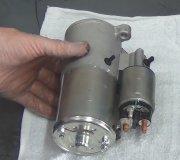Since this problem is acting up regularly for you, that will make it easier to find. A cheap digital voltmeter can be used but in this case, a test light would be faster. The only thing that can't be checked on GM vehicles is the battery connections because of their side post terminals. Start with the test light connected to the two battery cables. If the test light is dim there, the cable connections must be cleaned and tightened, or the battery has a bad connection internally and must be replaced.
If the test light is nice and bright, move the probe or clip lead from the negative post to the engine block. Also move it to the body sheet metal. There will be a smaller wire attached to the fender that comes from the battery negative post. The light must be bright at both of those places. The wire to the fender is the return for all of the lights, the horn, the starter relay, etc. It is a common source of a bad connection, especially if the inner fender is getting rusty. Next move the probe or clip lead from the positive post to whatever the cable goes to. On older vehicles, that was the starter. Its terminal was used as a convenient tie point for other wires to branch off from. On newer vehicles, look for an underhood fuse box with a smaller cable going to it from the positive battery post. Move your probe to the connection on that box. You're looking for the point at which the test light becomes as dim as the other lights on the truck. When you find that point, that's where to look for the loose or corroded connection.
Caradiodoc
Was this helpful?
Yes
No
-1
Thursday, September 3rd, 2020 AT 5:15 PM
(Merged)



